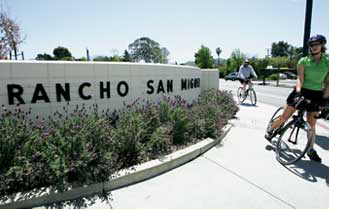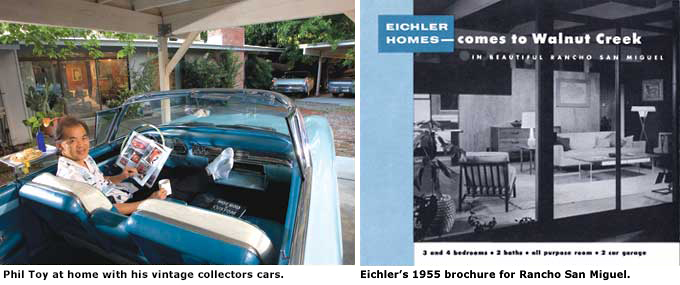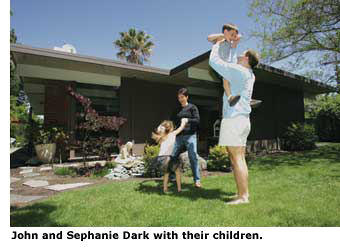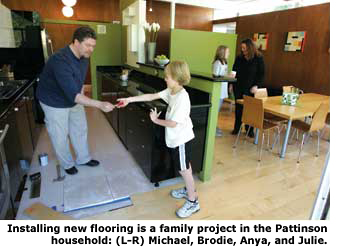The Eichlers of Rancho San Miguel - Walnut Creek
 Phil Toy expected to spend a few hours at Walnut Creek's Rancho San Miguel the first time he visited. That was six years ago—and he's still there.
Phil Toy expected to spend a few hours at Walnut Creek's Rancho San Miguel the first time he visited. That was six years ago—and he's still there.
A professional photographer and car collector, he figured the neighborhood of Eichler homes would make an attractive backdrop for the '64 Ford Galaxie he was shooting for the cover of a car collectors magazine. Toy honed in on a house with a cactus out front for that Southwest feeling. That's when a woman drove up and told him the house was for sale. "I bought it right on the spot," he says. "The house was built in 1957 and my cars were from '57. I bought the house to match the cars."
Rancho San Miguel, a subdivision of 535 homes—375 Eichlers, the rest standard ranches—is one of Joe Eichler's lesser-known neighborhoods. But it's about to enter the spotlight, both by celebrating its 50th anniversary (the neighborhood was built from 1955-'58) and by seeking a spot on the National Register of Historic Places.
Rancho San Miguel is no longer the rural outpost that it was in the beginning. But it retains much of the original character—both architectural and personal. From the start, the neighborhood attracted individualists who were willing to try something new and different, and it still does. The East Bay suburbs can be bland, but you'd never know it from meeting the people who live in Rancho San Miguel.
"Eichler would do everything he could to get what he considered the right people in here, people who were artistically sympathetic and in the arts, and not people who would have a closed mind to anything," says Charles Dorsett, an original owner who helped design the neighborhood as a young architect with the firm of Anshen + Allen.

"Everybody was an activist in some way," says Dorsett's wife, Dorothy, who's been long active in the Sierra Club and other organizations. "They wanted to improve things."
"The people who are attracted to these houses are open-minded," Charles Dorsett says, referring to newcomers as well as to original owners, "and they probably are college educated and they probably have taken art appreciation and have an interest in the arts."
Dorsett, who has had a second career as an actor, singer and set designer for community and professional theater, has singers, musicians and artists for neighbors. "The people here," he says, "are interesting." Original buyers were teachers, doctors, architects, engineers; and of varied ethnicities—Japanese and Chinese, Jewish, Mormon, African American—a highly unusual mix in mid-'50s suburbia.

Aileen Haslett may have been a typical buyer. "I was just sick and tired of living in a ranch style home," she says. "You could be blind-folded and find your way around. This was so different." "It was the modern architecture," original resident Bruce Good says of the attraction, "and the light and the style."
It took courage to live in an Eichler. "People we knew thought we were crazy because we moved into this strange house," says Dora Good, who bought a new home in Rancho San Miguel with her husband Bruce. Bruce, an engineer at Lawrence Livermore Laboratory, had to put up with criticism from close quarters. "My mother, she said they all look like garages. I resisted any resentment at her judgments."
It also took courage to move to Walnut Creek, one of the most sophisticated small cities in the Bay Area today, but rustic and remote in the mid-'50s."This was really the only tract in the entire valley," Charles Dorsett recalls. "This was all horse country."
"This was just a wide open mud prairie," says original resident Ruth Whalen, who would hike through the neighborhood after her husband left for work every morning. "The people were pioneers," Dora Good says.
The Whalens' house even looked like a pioneer homestead—surrounded by their plots of asparagus, melons, tomatoes, and green and red peppers, which they shared with the neighbors.

Folks moving to Rancho San Miguel today are no longer pioneers. But by all accounts they resemble their predecessors. "It seems to be a little touch of the eccentric," says Julia Pattinson, who recently moved into the neighborhood with her husband and two children. "It's a nice mixture of people." "Families come and go," says Haslett, "and the same type of people seem to buy Eichlers. We used to call them eggheads."




